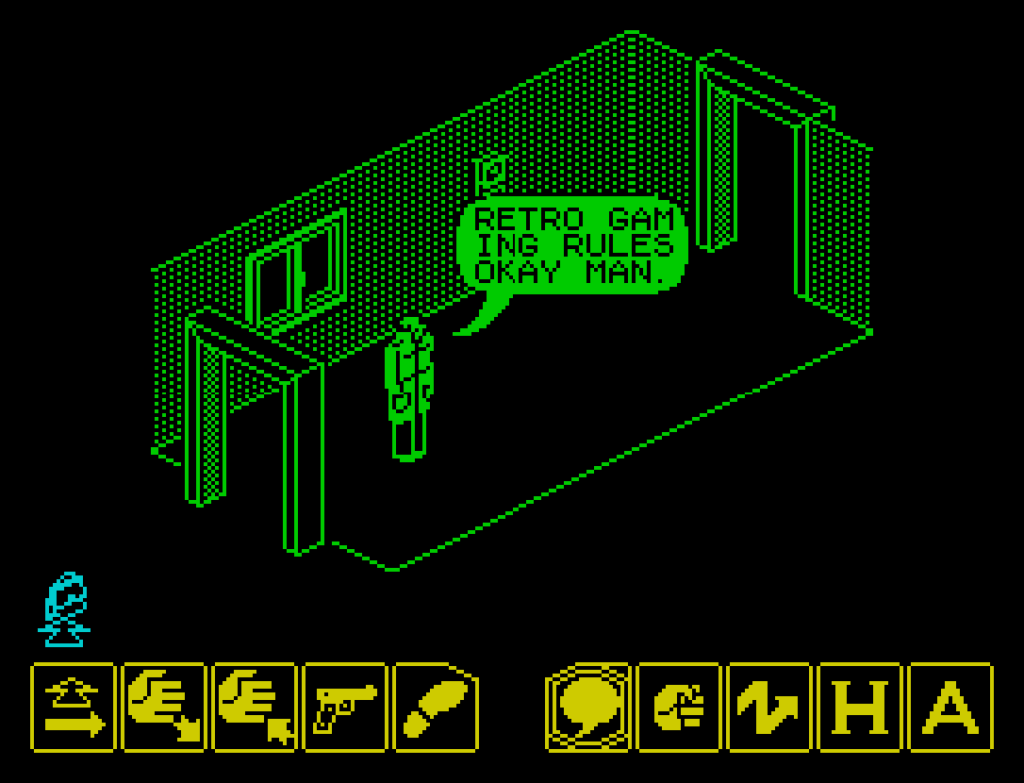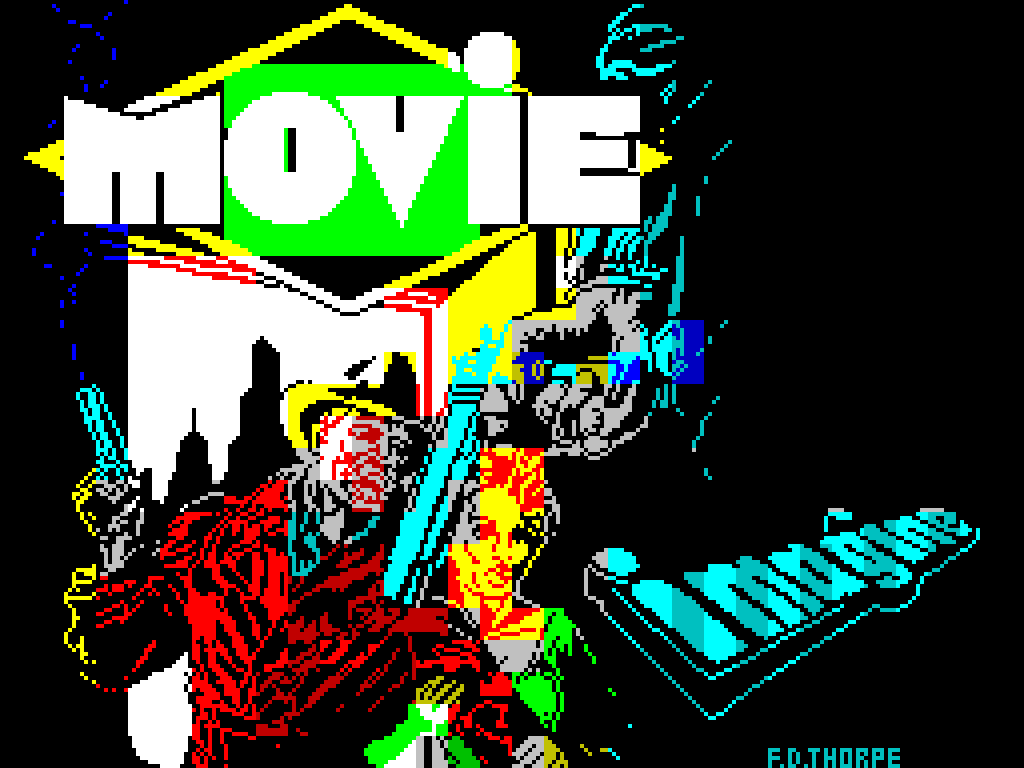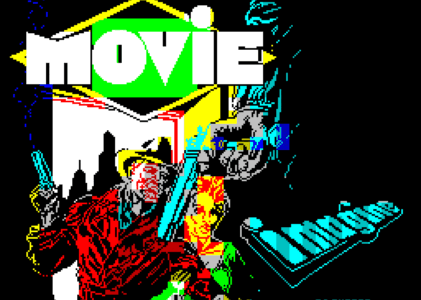The ZX Spectrum, an 8-bit personal home computer released in the United Kingdom in 1982 by Sinclair Research, is often celebrated for its significant role in the video game industry. It was a pioneer not just for affordability but also for fostering a vibrant game development scene. Among its extensive library, one game that stands out for its unique approach is M.O.V.I.E, released by Imagine Software in 1986. This game combined elements of adventure, puzzle-solving, and a noir cinematic aesthetic in a way that was groundbreaking for its time.
Overview of M.O.V.I.E
M.O.V.I.E is set in a version of 1940s Hollywood, where the player takes on the role of a private investigator. The game is infused with a film noir atmosphere, complete with moody visuals and a thematic soundtrack that resonates with the era it emulates. Players navigate through a series of film sets, solving puzzles and interacting with various characters to solve a mystery. The game’s setting in a pseudo-Hollywood studio, where each level represents a different movie genre, adds layers of narrative and visual diversity.

The Plot of M.O.V.I.E
The narrative of M.O.V.I.E takes players on an engrossing journey through the gritty and glamorous world of 1940s Hollywood. Players assume the role of a private detective, tasked with solving a mysterious case that unfolds within the confines of a movie studio. The plot cleverly integrates the thematic elements of classic film noir, including betrayal, intrigue, and moral ambiguity.
Setting the Scene
The game begins as the detective arrives at a bustling film studio, where an enigmatic movie director has been threatened by obscure forces. The studio, a labyrinth of movie sets, props, and bustling activity, serves as a multi-layered backdrop for the detective’s investigations. Each set within the studio represents a different genre, ranging from romance to horror, which not only diversifies the visual experience but also introduces unique characters and puzzles relevant to the genre’s stereotypes.
Unraveling the Mystery
As players navigate through various movie sets, they interact with a cast of characters that include actors, producers, and crew members, each with their own secrets and motives. Dialogues and interactions are crucial, as they can unveil clues or red herrings, depending on the player’s ability to question and observe. The detective must gather clues, which often involve solving puzzles that can range from deciphering a script to unlocking a director’s private office.
The Twist in the Tale
The intrigue intensifies as it becomes apparent that the threats to the movie director might be a smokescreen for more sinister undertakings within the studio. The detective learns of a plot that could shake the very foundation of the cinematic world, involving espionage and a revolutionary film technology that competitors are desperate to sabotage or steal.
Multiple Endings
One of the most innovative aspects of M.O.V.I.E’s plot is its branching narrative structure, leading to multiple possible endings. The conclusions depend on the detective’s decisions, the clues gathered, and how effectively the player interprets interactions with the game’s characters. This aspect of the game not only enhances replayability but also encourages players to think critically about the implications of their choices within the narrative.
Innovations in Gameplay and Design
- Genre Blending: M.O.V.I.E is particularly notable for how it blends different genres. While at its core, it is an adventure game, it incorporates puzzle elements and a detective story that requires critical thinking and attention to detail. This fusion not only made it stand out among other games on the ZX Spectrum but also added a layer of depth that engaged players more deeply.
- Graphical Presentation: For a platform limited by its 8-bit architecture, M.O.V.I.E pushed the boundaries of what was visually possible. It featured detailed character sprites and environments that were far more intricate than many contemporaries. The use of noir-inspired visuals, such as shadowy figures and dimly lit streets, helped create an immersive atmosphere that was rare in games from that period.
- Narrative Structure: Unlike many games at the time, which often lacked a coherent story, M.O.V.I.E presented a compelling narrative that players could unfold as they progressed. This emphasis on storytelling was a precursor to the narrative-heavy games that are popular in today’s gaming landscape. The game’s narrative also allowed for multiple endings, which was a novel feature at the time.
- Sound Design: M.O.V.I.E utilized the ZX Spectrum’s audio capabilities to enhance its film noir atmosphere. The soundtrack and sound effects were carefully crafted to match the visuals and narrative, providing an auditory experience that complemented the game’s cinematic feel.

The Cultural Impact and Popularity
M.O.V.I.E was not just a game; it was an experience that mirrored the escapism of the movies it emulated. Its release during the mid-80s, a time when cinema was experiencing a renaissance of sorts with blockbuster hits and technological advancements in film-making, helped it resonate with a broad audience.
The game’s appeal was also bolstered by its reception in the gaming community. Magazines such as Crash and Your Sinclair gave it positive reviews, praising its originality and depth. This critical acclaim helped cement its status as a cult classic among retro gaming enthusiasts.
Furthermore, M.O.V.I.E’s approach to storytelling and immersive gameplay influenced other developers on the ZX Spectrum and beyond. It showed that games could be more than just simple distractions; they could be complex, narrative-driven experiences that engage players intellectually and emotionally.
M.O.V.I.E
M.O.V.I.E stands out as a testament to the innovation and creativity of the early video game industry. Its unique blend of gameplay mechanics, narrative depth, and cinematic presentation set it apart from other titles on the ZX Spectrum and contributed to its enduring popularity. For fans of retro gaming, M.O.V.I.E offers a fascinating glimpse into the past and a reminder of how far video game development has come.
In retrospect, M.O.V.I.E was not just a product of its time but also a harbinger of future trends in gaming. It exemplifies how the constraints of early gaming technology were not barriers but rather catalysts for creativity and innovation. This game remains a significant piece of the ZX Spectrum’s legacy, continuing to inspire both players and game developers alike.

